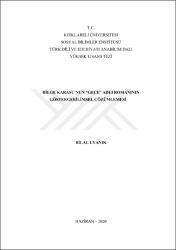| dc.contributor.advisor | İskender, Halil İbrahim | |
| dc.contributor.author | Uyanık, Bilal | |
| dc.date.accessioned | 2021-12-11T19:41:46Z | |
| dc.date.available | 2021-12-11T19:41:46Z | |
| dc.date.issued | 2020 | |
| dc.identifier.uri | https://tez.yok.gov.tr/UlusalTezMerkezi/TezGoster?key=Eb5EkakJlp3olBdo_wNEGaHA_CoPkY6c7-VZBfBGxZ5hMfEb5V7QFtz-7z1-5ELr | |
| dc.identifier.uri | https://hdl.handle.net/20.500.11857/1596 | |
| dc.description | YÖK Tez: 627932 | |
| dc.description.abstract | Bu çalışmanın amacı Bilge Karasu'nun (1930-1995) Gece adlı romanının göstergebilimsel bir tahlilini sunmaktır. Bu doğrultuda, Fransız edebiyat kuramcısı Gérard Genette'in (1930-2018) söylem çözümleme yöntemi metne uygulanmıştır. Bu yöntem doğrultusunda, Gece düzen, hız, sıklık, ses ve kip unsurları bağlamında şekil itibarı ile tetkik edilmiş, metnin grameri çıkarılmaya gayret edilmiş, anlaşılırlığın temini adına grafiklerden ve şekillerden yararlanılmaya bilhassa özen gösterilmiştir. Böylelikle, yöntemin Türkçede analitik bir tarif ve tatbikini sunmak amaçlanmıştır. Metnin tahlilinde, çalışmanın ana gövdesini teşkil eden Genette'in yöntemi haricinde, (i) Umberto Eco'nun (1932-2016) açık yapıt kavramı, Maurits Cornelis Escher'in (1898-1972) tabloları ve (iii) Carl Jung'un (1875-1961) arketiplerinden istifade edilmiştir. Bu suretle, metnin farklı okumaları, metnin var ettiği dünyanın izafiliği ve imkânsızlığı ve metindeki karakterin veya karakterlerin bireyleşme süreci izah edilmeye çalışılmıştır. | |
| dc.description.abstract | This study intends to present a discourse analysis of Bilge Karasu's (1930-1995) novel named Night within the framework of the semiotic analysis method of the French literary theorist Gérard Genette (1930-2018). In line with this method, Night is stylistically analyzed in terms of speed, frequency, sound and mood elements, its grammar is revealed, and special care is taken to make use of graphics in order to ensure clarity. The main purpose here is to present an analytical description and application of the method in a Turkish text. Apart from Genette's method, which forms the basis of this work, the study also benefits from (i) the concept of the open work by Umberto Eco (1932-2016), the paintings by Maurits Cornelis Escher (1898-1972) and (iii) the archetypes of Carl Jung's (1875-1961). The study thus attempts to illustrate different readings of the text, the relativity and implausibility of the world the text conjures up, and the process by which the character(s) in the text experience individuation. | |
| dc.language.iso | tur | |
| dc.publisher | Kırklareli Üniversitesi | |
| dc.rights | info:eu-repo/semantics/openAccess | |
| dc.subject | Türk Dili ve Edebiyatı | |
| dc.subject | Turkish Language and Literature | |
| dc.subject | Gece | |
| dc.subject | Night | |
| dc.subject | Gösterge bilim | |
| dc.subject | Semiotics | |
| dc.subject | Göstergebilimsel analiz | |
| dc.subject | Semiotic analysis | |
| dc.subject | Karasu, Bilge | |
| dc.subject | Karasu, Bilge | |
| dc.subject | Roman | |
| dc.subject | Novel | |
| dc.subject | Söylem | |
| dc.subject | Discourse | |
| dc.subject | Türk romanı | |
| dc.subject | Turkish novel | |
| dc.subject | Yapısal dilbilim | |
| dc.subject | Structural linguistics | |
| dc.subject | Yeni Türk edebiyatı | |
| dc.subject | New Turkish literature | |
| dc.title | Bilge Karasu'nun "Gece" adlı romanının göstergebilimsel çözümlemesi | |
| dc.title.alternative | A semiotic analysis of Bilge Karasu's novel named "Night" | |
| dc.type | masterThesis | |
| dc.department | Enstitüler, Sosyal Bilimler Enstitüsü, Türk Dili ve Edebiyatı Ana Bilim Dalı | |
| dc.identifier.startpage | 1 | |
| dc.identifier.endpage | 144 | |
| dc.relation.publicationcategory | Tez | |
| dc.institutionauthor | Uyanık, Bilal | |



















